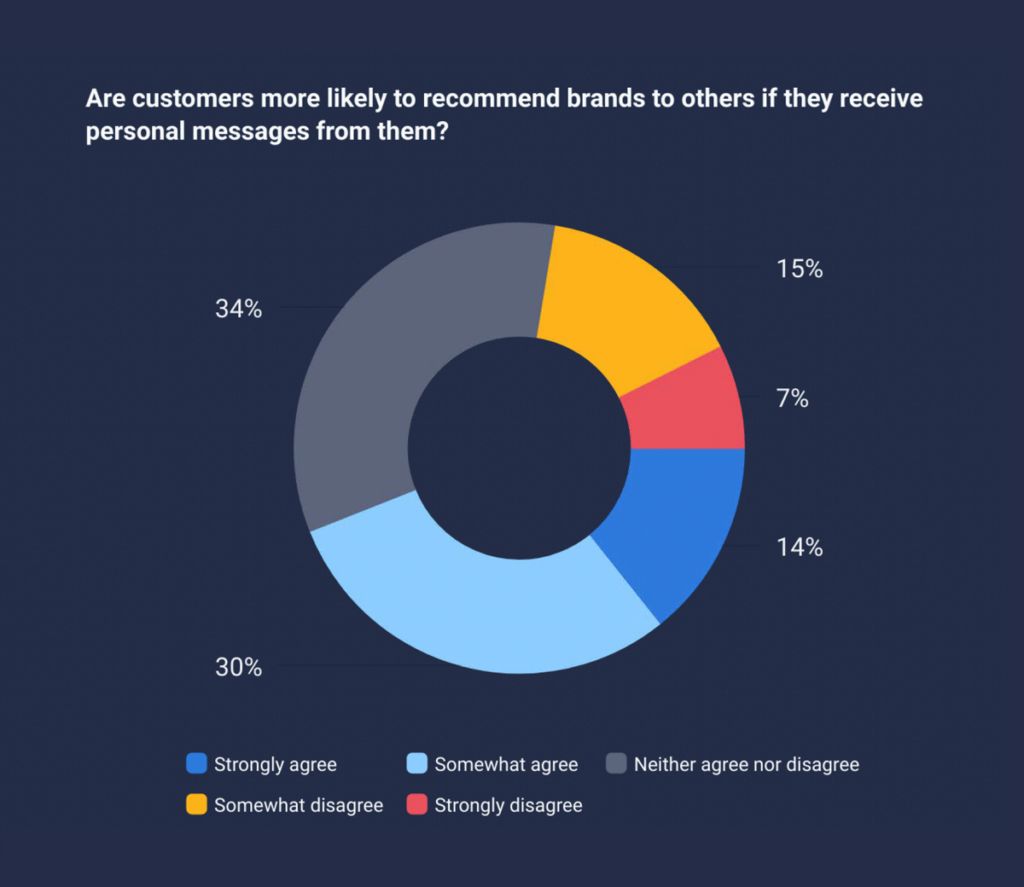Many enterprises face this challenge – I have all this data at my fingertips, but how can I find a way to use it effectively to create real time personalization at scale?
Here’s another conundrum: Personalization is a crucial factor in driving revenue for brands, but achieving the right balance can be challenging. Customers want dynamic personalized content but it needs to really resonate with them.
To address this, big brands need to first understand what consumers want and their purchasing habits.
How do consumers want to receive marketing messages from brands?
Mobile shopping makes buying online easy and convenient and consumers are increasingly turning to their smartphones to make purchases. In fact, a recent survey conducted by MessageGears found that 55% of consumers place most of their online orders solely with their mobile devices.
That may lead some to conclude that sending SMS messages to consumers’ mobile devices is the way to go to reach their customers and create real-time personalization. But be careful – of the consumers surveyed by MessageGears, 41% said they don’t want SMS messages from brands.
Instead, they prefer email, with 51% stating email is the marketing message they prefer to receive most from brands. In fact, email was the top driver of online sales according to our survey: 59% of consumers said they’ve made a purchase directly from a promotional email.

Now, that doesn’t mean big brands should drop other types of messaging or that email is the only way to go when creating 1:1 marketing messages. Far from it. But it does show the importance of email. So if you’re struggling to create real-time personalization at scale, hone in on your 1:1 email marketing first. Then look at other channels, such as in-app notifications, for opportunities to improve personalization.
And it is imperative that brands improve their personalization. Half of the consumers surveyed by MessageGears said they’re annoyed when brands send generic messages. What’s more, over 75% stated they unsubscribe from brands that send too many irrelevant messages. Contrasting this, two-thirds of consumers stated they’re more likely to buy from brands that create a personalized customer experience. They’re also more likely to recommend those brands to others.

One way big brands can improve their real-time personalization is to look at what other enterprises are doing – even if they’re not in your industry or targeting the same persona. Use their 1:1 messaging campaigns as inspiration. Consumers say these brands are top of mind for sending personalized and relevant messages they look forward to (in no particular order):
- Amazon
- Walmart
- Best Buy
- Chewy
- The Home Depot
- eBay
- Sephora
- Macy’s
- Dick’s Sporting Goods
- Target
- Gap
- Nike
So, how are enterprises like these managing to send relevant, highly personalized messages in real time?
The secret to creating real-time personalized marketing messages
You may have attributed a company’s promotional messaging success to a huge marketing budget or team. This only takes a company so far, though. The real secret often lies in how these companies manage and access their customer data.
Years of fragmented marketing have resulted in data silos, making real-time personalized marketing a pipe dream for many companies. The fragmentation is often a result of the heavy reliance on cloud software as a service (SaaS) to manage customer data. With every new cloud platform you use, you create a new database. Work then multiplies because each cloud updates independently and allows little flexibility in the way you can integrate data. This makes it difficult and sometimes impossible to personalize effectively.
As an alternative, you can house data in a centralized database that cloud applications can access via hybrid cloud computing. Brands that centralize their data gain a unified view of the customer journey. This paves the path for true personalized real-time marketing.
Below are three benefits and tactics all brands can use to centralize their data and improve their micro-personalization.
1) Be ready for real-time marketing opportunities without having to predict the future
Even if you could upload all of your customer data to a SaaS platform like an email service provider (ESP), the data security concerns alone would stop most companies from doing so.
As a result, marketers often find themselves cherry-picking data to be uploaded to a SaaS provider for specific campaigns. That may work well for planned campaigns but it becomes tricky when trying to take advantage of unpredictable, real-time marketing opportunities.
The demands of real-time marketing means data isn’t always uploaded when you might need it. By the time marketers are able to get data uploaded and synced in the cloud, it can be days or even weeks old. Not exactly what you would call real-time marketing.
To avoid the delays caused by syncing and uploading large amounts of data, consider the improved “composable” approach to SaaS. This allows your SaaS platform (like your ESP) to tap directly into your centralized database without having to sync or store data outside your firewall.
With a composable CDP, you can access comprehensive customer data for real-time campaigns by pulling best-of-breed capabilities together in a new way – and your data warehouse serves as the foundation for it all.
Everything around the data cloud is either feeding it with data or running on top of it as a connected application in the composable environment.
With the composable approach you no longer have to predict the future and anticipate exactly what data you might need to be located in the cloud at any given time.
You have full access to all of your data. This way, whenever a real-time marketing opportunity arises, you don’t spend time uploading data that might not be already stored with your ESP or SaaS provider.
2) Segment based on data too sensitive to store in a third-party platform
SaaS marketing tools that make personalization and data segmentation possible often elicit security concerns related to uploading and storing sensitive customer data in a third-party platform. But data security and personalization don’t have to be mutually exclusive.
You can create highly personalized messages based on sensitive customer data without uploading the sensitive data to an ESP or other martech platform. The dynamics of how you segment data change when the segmentation takes place behind your company’s secure firewall in a centralized database.
You would probably never dream of sending data with your customer’s credit scores, purchase history, or medical records to an ESP or other martech platform. That doesn’t mean, though, you can’t segment customers based on sensitive categories that already exist within your database. Then you send only the necessary information (sans the sensitive data) to your SaaS platform for processing and delivery.
This ability to personalize while protecting sensitive customer information was crucial for Chick-fil-A, who wanted to keep customer data secure from any third party — MessageGears included.
Using MessageGears’ solution, Chick-fil-A is able to confidently collect data while assuring customers that they have one of the most secure data solutions in the industry, greatly reducing the chances of a costly data breach.
3) Improve personalization and real-time marketing with a unified global customer view
A key step toward real-time marketing messages means transitioning from disconnected customer interactions to a unified view of customer engagement.
But fragmented marketing means many companies have data stored in silos that prevent marketers from having a complete view of customers. The result is customers often receive messages that are irrelevant to their situation.
The adoption of multiple platforms that all require their own database limits how organizations can use their data. For businesses that want to successfully incorporate personalized, real-time marketing into their strategy, storing all facets of marketing data in a single database is a must.
But customer data is not the only data marketers need to access. Marketers may also need access to data such as inventory levels that update in real-time, geolocation data, shipment tracking data, etc. In fact, your success in real-time marketing depends upon the accessibility of your entire data set, not just customer data.
As the number of messaging channels has grown for brands, so has the need to deliver messages that are relevant to each individual. With so much data being collected, organizing and accessing it for the sake of tailoring your message keeps getting tougher. That’s why the secret to personalized real-time marketing lies in how you manage and access your customer data.
Learn more about how MessageGears can help improve your access to data – and your ability to personalize your marketing messages.






